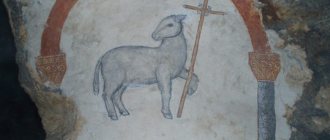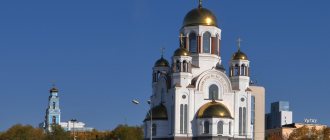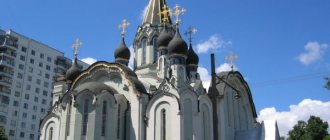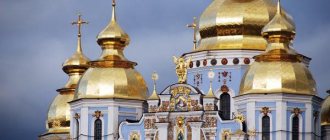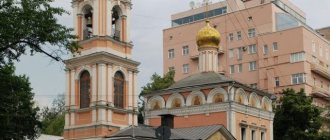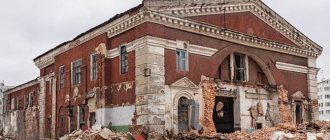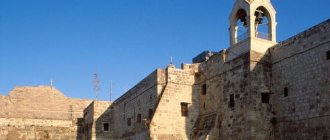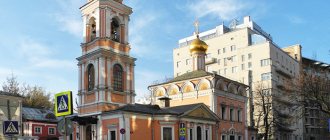Church of the Resurrection of Christ in Kadashi (Russia) - description, history, location. Exact address and website. Tourist reviews, photos and videos.
- Last minute tours
to Russia
In Zamoskvorechye, rich in churches, each temple is a separate story, which is surprisingly tightly intertwined with the fate of Moscow. In Kadashi, an ancient settlement where coopers and weavers lived for centuries, there is an ancient Orthodox church. The Church of the Resurrection of Christ, located literally a stone's throw from the Tretyakov Gallery, as centuries ago, occupies the dominant status of “cathedral” among other churches in Zamoskvorechye.
This was facilitated by its favorable location between two main roads to the south: Ordynka and Polyanka streets.
Story
The earliest mention of the church in Kadashi is found in a letter from Moscow nobleman Ivan Patrikeev dated 1493, where it is called “the Church of the Resurrection on Gryazekh” - a name that speaks of medieval concepts of purity.
The first stone building, built in 1657, known from official documents, lasted only 30 years. In 1687, with money from the artisans of the Kadashevskaya Sloboda and ordinary residents, it was decided to build a new two-story, five-domed temple. On its western side, a six-tiered bell tower rose 43 meters high.
The temple was built in the Moscow Baroque style, the distinctive features of which are graceful proportions and an exquisite, carved silhouette.
In 1934, government institutions were located in the temple building, including the KGB archive and a sports club. In the 1950s its interiors were restored under the direction of G. V. Alferova. The Church of the Resurrection of Christ received its first believers only in 1992, after the organization of the parish. On December 1, 2006, the temple was transferred to the Russian Orthodox Church.
LiveInternetLiveInternet
Quote from NADYNROM message
Read in full In your quotation book or community!
Opposite the Kremlin in Zamoskvorechye there was one of the largest and richest settlements in Moscow in the 17th century - the palace Kadashevskaya Sloboda. Its historical borders run along the modern Kadashevskaya embankment, Bolshaya Ordynka and Yakimanka streets. The name of the settlement comes from the village of Kadashevo, which was first mentioned in the will of Grand Duke Ivan III to his son Vasily in 1504. It is widely believed that the name of the village reflected the main occupation of its inhabitants in the 15th-11th centuries - the manufacture of cades (barrels). However, this is not confirmed in the documents. Even before the formation of Kadashevskaya Sloboda, the center of Zamoskvorechye became the Church of the Resurrection of Christ. The first mention of a wooden church is in a letter from the Moscow governor Prince Ivan Yuryevich Patrikeev to his sons, drawn up in 1493, where it is called “the Church of the Resurrection, on Gryazekh”. This name was associated with the spring floods of the Moscow River and the close location of the temple to the swampy shore. And since 1625, regular entries about the temple appear in the Patriarchal salary books.
According to modern scientists, the Church of the Resurrection in Kadashi served as the main vertical, compositional dominant and was the “cathedral” temple of Zamoskvorechye. It defined the main urban axis of Moscow, running from the bell tower of Ivan the Great through the Church of the Resurrection in Kadashi to the palace Church of the Ascension in Kolomenskoye. The first stone building, built in 1657, lasted no more than 30 years, and in 1687, under Patriarch Iaokim, construction began on a new two-story, five-domed temple. Construction was carried out at the expense of residents of Kadashevskaya Sloboda - merchants Kodrat Markovich Dobrynin and his son Longin Kondratovich. The southern asp and a fragment of the southeastern corner of the quadrangle, preserved from the ancient church of 1657, were built into the new building. And in 1695, a slender six-tiered tented bell tower was built, which was popularly called “candle”. It is assumed that the builder of the temple was Sergei Turchaninov, a native of Kadashi and an associate of Patriarch Nikon, who completed the Resurrection Cathedral in the New Jerusalem Monastery after his death. The Church of the Resurrection of Christ in Kadashi is an outstanding monument of the “Moscow Baroque”. The Kadashevsky Church was famous for its interior decoration, which the parishioners and benefactors of that time took great care of. In the interior of the upper church, the greatest artistic value was the six-tiered iconostasis, 12 meters high and 11 meters wide, which has been described as one of the best works of carved art of the 17th century. Tsar's isographers Pyotr Belyaev, Nikolai Solomonov, Pyotr Korobov and Pyotr Bilindin, one of Simon Ushakov's best students, were invited to paint the walls and paint icons.
During the War of 1812, the temple was looted, the ancient painting of the 17th century was damaged, and the French built a stable in the lower church. When leaving, they set fire to the temple on the western side, the fire, spreading to the bell tower, reached the window at the right choir and... went out. In 1848, under the rector Fr. John Margaritov, a new mural was made by the artist P.N. Shchepetov, and the iconostasis, starting from the primer, was re-gilded. After the restoration was completed, the temple was re-consecrated by Metropolitan Philaret in 1849. The last construction work in the temple was carried out in 1860 under the leadership of architect N.I. Kozlovsky. The ancient walls of the galleries were broken, and the new ones were set back by 3.2 meters for expansion purposes. The church building has survived in this form to this day. The temple has long been famous for its bell ringing. The main bell was cast in 1750 and its weight was 400 pounds, i.e. approximately 6.5 tons! It was cast by the famous master Konstantin Mikhailovich Slizov, who a decade later cast the Great Assumption Bell at the Bell Tower of Ivan the Great. This bell had a surprisingly soft, velvety sound. At the Kadashevskaya Bell Tower there was a wonderful selection of bells “of different sound characteristics and, moreover, with pleasant timbres.” After the temple was closed, the bells disappeared. But in the 1990s. It became known that some of them are in the Bolshoi Theater and are used in “Khovanshchina” and “Boris Godunov”. Despite all the efforts of the parishioners, the temple was closed in 1934. After that, the temple housed various government institutions, including such as the “sausage factory sports club.” The iconostasis, according to some sources, was destroyed, according to others, it was moved to the Trinity Church in Ostankino, and in the Kadashevsky Church only its lower tier survived. Two icons of the late 17th century - Bogolyubskaya and the Pantocrator - were sent to the Tretyakov Gallery.
From 1946 to 1966 the famous specialist Gali Vladimirovna Alferova carried out a partial restoration of the temple. Its historical appearance was restored. In 1964, the restored temple building was leased to the All-Russian Artistic and Scientific Restoration Center named after Academician Grabar, an institution dedicated to restoring and preserving artistic values. After perestroika, a protracted struggle for the building of the temple began between the All-Russian Scientific Research Center and the church, which ended in favor of the believers. Now the Church of the Resurrection of Christ is facing another serious danger, which has become, alas, commonplace for Moscow - the construction of an elite office and residential complex “Five Capitals”, for the sake of which the historical buildings of Kadashevskaya Sloboda could be destroyed, and the view of the beautiful temple will be closed on three sides. An active struggle against new development unfolded. How it will end is still unknown. I would like to hope for the best, but... And this is how the Church of the Resurrection of Christ in Kadashi looks in a pre-revolutionary photograph from Naydenov’s album:
©Based on materials from the site https://www.kadashi.ru
What to see
The interior features wall paintings from the mid-19th century and a fence from around the same time. Shrines of the temple: particles of the relics of the martyr Eutropius of Rome, St. Job of Pochaev, Kostroma martyrs of the Time of Troubles. In the small chapel of the Royal Martyrs there is an icon of Nicholas II written on stone.
However, visiting the Church of the Resurrection of Christ will be interesting not only for deeply religious people. At the church there is a museum “Kadashevskaya Sloboda”, located in one of the church buildings. It was created on the basis of a rich collection of ceramics, arrowheads, household items and tiles found during archaeological research, restoration and laying of communications along Kadashi. Some items were donated by parishioners. As a reminder of the persecution of the church, the walls are decorated with crosses from destroyed and unrestored Moscow churches, collected by the famous restorer P. D. Baranovsky. Right in the middle of the museum hall there is a model of a peasant hut, which you can study both from the outside and from the inside: tiny furniture and traditional peasant household items are neatly arranged in the house.
Resurrection Church: architecture and formation
Externally, the temple in Kadashi was a little different from what we see now: there was no bell tower yet, and huge stairs led to the shrine on three sides.
The construction of the new Church of the Resurrection of Christ also reflected some architectural innovations that had just appeared in Rus'.
So, on the lower tier there is a gallery-gulbische. The pediments were decorated not with traditional kokoshniks, but with lace “combs”. The drums of the temple heads are faceted, each face is marked. The central drum is two-tiered; small windows in it create some openwork in the upper part of the church.
At the end of the 17th century, a bell tower was built, and the Church of the Resurrection of Christ itself underwent some changes - 2 symmetrical porches were erected. After some time, the apses of the upper part of the temple and the walkway gallery were expanded.
Inside the shrine, a wooden carved iconostasis, more than 12 meters in height, took its place. Its gilded columns were decorated with carvings in the form of grape leaves. The walls of the temple were painted with royal iconographs.
Patronal holidays[edit]
Resurrection of Christ (Easter)
— Rolling date
Dormition of the Blessed Virgin Mary
— August 28 (main altar of the lower temple)
Icon of the Blessed Virgin Mary "Tikhvin"
- July 9 and
St. Nicholas the Wonderworker, Archbishop of Myra, Saint
- May 22, December 19 (altars of the lower church)
Keepers of memory. Church of the Resurrection of Christ in Kadashi
Audio |
The new episode of the program is about the Church of the Resurrection of Christ in Kadashi. Archpriest Alexander Saltykov, dean of the Faculty of Church Arts at PSTGU, talks about the history, architecture and interior decoration of this ancient church. Hello, dear TV viewers!
We are in Moscow near the ancient Church of the Resurrection of Christ in Kadashi. About this temple - in our today's episode of the program “Keepers of Memory”. Archpriest Alexander Saltykov, rector of the Church of the Resurrection of Christ in Kadashi, dean of the Faculty of Church Arts of PSTGU, member of the Union of Artists of Russia, senior employee of the Central Museum of Ancient Russian Culture and Art named after Andrei Rublev:
– We have an upper church and a lower church: the upper one is dedicated to the Resurrection of Christ, the lower one is dedicated to the Dormition of the Mother of God. It in its present form dates back to the 17th century. In general, according to documents, there should have been a church here at the end of the 15th century. And, apparently, at first there was a wooden temple, which in the 17th century was rebuilt into a stone one, and at the end of the 17th century it was rebuilt again in the Naryshkin Baroque style and acquired a modern look.
Or rather, almost modern. In the 19th century, after the fire of Moscow (the fire, in particular, was in Zamoskvorechye), a grandiose renovation was carried out, the temple was somewhat expanded. The altar in its modern form dates back to the 19th century, but it must be said that the architects of the 19th century successfully blended into the style of the temple, and now it has a completely uniform look stylistically. The extensions at the bell tower level look somewhat separate: they actually fall a little out of the general style, because they were built separately to expand the premises.
There was a fairly large cemetery next to the temple, of course, as always next to the church. But Moscow was a green city, and there were gardens all around. In fact, the temple was, in general, a court temple, it served the needs of the Tsaritsyn court, quite wealthy people lived here, some images of that time have been preserved - in general, there was the so-called Kadashevskaya Sloboda. Unfortunately, now it no longer exists.
The temple was also famous for its bell ringing. Unique bells were cast by the famous master Slizov at the end of the 18th century, two personalized bells. During Soviet times, they were taken away from the temple after its closure and temporarily placed in the Bolshoi Theater. Temporarily. For some reason the Bolshoi Theater still does not give them away; we have repeatedly raised this issue.
Now a lot of work is being done in the temple; in particular, we are grateful to the city for reinstalling the old communications. A huge amount of work has been done throughout the entire territory, and this is very gratifying, because a modern building cannot live without repairs. A lot of good repairs have been made everywhere, including the temple.
In Soviet times, all the property of the temple was liquidated, only a few icons remained, which are in different museums, and they are of completely different levels. There were no iconostases, only photographs remained. The temple had an iconostasis with remarkable artistic carvings dating back to the 18th century.
And back in 2009, some miracle happened: I was sick then, I was not there, and in my absence a certain girl came to the temple, who said that she was an employee of a museum. She said that they have the iconostasis of our church in the museum and we can take it. Imagine? That is, after the revolution, the specialists were not all imprisoned at once, they were imprisoned gradually, they managed to do something. And here some honest people, realizing the great value of this iconostasis, dismantled it, put it in boxes and sent it to some institution, where these boxes were placed in the basement. There is quite a lot left – about a third.
I have a museum at my temple. And now we are simply displaying part of this iconostasis in the museum. Due to the fact that our temple is being renovated, we are, of course, thinking about trying to restore the iconostasis if possible, but this is a very difficult job. It requires, first of all, large material costs. And if any of our viewers respond to this question and want to participate in the fate of such a unique iconostasis, we, of course, can only welcome this. And I even suggest you listen to my message. This is one of the main tasks today.
As for the paintings, everything is not easy. The fact is that during the fire in Moscow, Zamoskvorechye was burning, and nearby houses were burning. And there is a legend that the French, fleeing from Moscow, allegedly piled some wooden things in this temple and wanted to set it on fire. Apparently they didn't have time to do it. Personally, I have a little doubt about the veracity of this legend, because the fire in Moscow lasted only a few days. During these few days, Moscow managed to burn down, but the French continued to stay here for some time.
But, one way or another, the temple suffered during the French invasion; it was very much plundered, because its abbots spent a very long time restoring, in particular, the paintings. But in those days they did not know how to appreciate ancient paintings; they were replaced with new ones. We only have small fragments of the 18th century left, and the rest of the painting was done in the 60s of the 19th century. For my part, I can say that, of course, we live in the 21st century and must respect any earlier period. About one and a half years have already passed since the paintings were completed, but in view of the great loss of temple art, of course, they acquire a certain value.
As a specialist, I can say that we have complaints about this period as a whole, about the requirements that must be presented to church art, but nevertheless, experienced craftsmen were chosen. The temple was mainly painted by masters of academic training. But then, in the 20th century, these paintings suffered not from the French, but from their own people. There was quite a complex story here; in this temple there were clubs, a warehouse, restoration workshops, and something else. And although, of course, restorers are cultured people, many thanks to them, but nevertheless the losses are very significant.
Restoring all this is not easy; there are many questions, including the feasibility of restoring the paintings in full. Because the Old Russian style is still much more consistent with the spirit of Orthodox worship, the liturgical spirit, than academic paintings. There is a lot that remains unresolved, a lot remains to be done. We try to approach these issues slowly, thinking that for future generations we must, of course, leave something meaningful and spiritually valuable.
The renovation of the temple is at the final stage, I must say. We are very grateful to the Ministry of Culture and personally to Mr. Minister, because he lives nearby and comes to see us sometimes, shows a certain interest, and supports us. This is very good.
We are in the lower church - the Church of the Assumption of the Blessed Virgin Mary. The side chapels are dedicated to the Tikhvin Icon of the Mother of God and St. Nicholas. These two small chapels were built already in the 18th century. The main throne is the Assumption. We have practically nothing preserved from the early paintings, and this is due, firstly, to the fact that Moscow was captured by the French, and there is a legend that there was almost a fire here. Although there apparently was no fire here, it is clear that the temple was badly damaged.
Nevertheless, the restoration of the temple lasted a very long time - until the 60s of the 19th century. Over these decades, the side aisles and apse were expanded. And in these rooms the painting was done anew in the 60s of the 19th century. At that time, of course, academic painting dominated, because medieval art was just beginning to be studied, and, accordingly, artists who graduated from the Academy of Arts were attracted here.
Our domestic artists, who painted this temple in the 60s of the 19th century, were interested in early Christian art and used early Christian motifs in the painting of this temple, especially in the central part. Obviously, they were attracted by the fact that there is a low vaulted room on four supports, and this design is reminiscent of early Christian churches: both underground catacombs and above-ground ones.
In particular, a cruciform composition is used here (along the ribs of the vaults that form a cross). In the center is an image of the Epiphany, or Epiphany. And we see exactly this composition - in general terms, of course - in the famous Ravenna baptisteries, known as the Orthodox Baptistery, the Arian Baptistery, the difference between them is about 100 years, 5th-6th centuries. These famous baptisteries were made using the mosaic technique, which, of course, no one was going to repeat here. This is an oil painting, but the principle of placing the Epiphany of the Lord in the center at the intersection of the cross is used, which connects the picturesque images with the mosaic decorations of Ravenna that I indicated. On the other hand, more deeply, the cross-shaped composition itself is associated with catacomb paintings. Naturally, the style here is dominated by the academic style of the mid-19th century, as was possible for us in those days. But here we are at the beginning of studying the foundations of Christian art in the Russian Church.
Dear TV viewers! We have completed the story about the Moscow Church of the Resurrection of Christ in Kadashi. All the best! See you again!
Author and presenter of the program Elena Chach
Recorded by Elena Churina
HISTORICAL REFERENCE
| The parish of the Church of the Resurrection in Kadashevskaya Sloboda has been known since 1493. The modern building of the four-altar, two-story church was built in 1687. Architect S. Turchaninov. The main altar of the upper tier is consecrated in the name of the Resurrection of Christ. The central altar of the lower church is consecrated in honor of the Dormition of the Mother of God, the right aisle is in honor of the Tikhvin Icon of the Mother of God, the left aisle is in honor of St. Nicholas of Myra. During the years of persecution, the parish was deregistered, and the church was closed for worship and transferred to the national economy in 1934. In 1992, the parish was revived and received legal registration, and in 2004 the upper church was transferred to the parish; in 2006 - the lower temple. From 2004 to the present, restoration and repair work has been carried out in the temple building. On Holy Saturday, April 23, 2011, the temple was visited by His Holiness Patriarch Kirill of Moscow and All Rus'. |
SACRED TEMPLE
The Kazan Icon of the Mother of God, preserved by parishioners after the closure of the temple in 1934. Icons of the Venerable Job of Pochaev, the Venerable Elders of Optina with the relics of these holy saints of God. Ark with the relics of many saints of the Russian Church.
WORSHIP
On Saturdays and Sundays, as well as on the days of the twelve and great holidays, on the days of remembrance of the dead, on the days of especially revered saints in the parish and at least twice a week. The Divine Liturgy begins on Sundays at 9.00, on weekdays at 8.00. All-night vigil at 17.00.
CLERGY
| Archpriest Alexander Alexandrovich SALTYKOV, acting rector of the temple. Born August 29, 1941. Education: Faculty of History, Moscow State University. M.V. Lomonosov, Orthodox St. Tikhon's Theological Institute. On October 14, 1983, he was ordained to the rank of deacon. September 12, 1984 to the rank of presbyter. In 1992, he was appointed acting rector of the temple. |
| Deacon Dimitry Nikolaevich KLYKOV |
DRIVING DIRECTIONS
Directions to the station metro station "Tretyakovskaya". Exit onto Bolshaya Ordynka Street, cross to the opposite side and go right until the first left turn, into 3rd Kadashevsky Lane. On 3rd Kadashevsky lane. go to the end and turn right into 1st Kadashevsky lane. From 1st Kadashevsky lane. first turn to the right, into Kadashevsky deadlock. Entrance to the temple territory is from Kadashevsky dead end, through the second gate on the left.
In the parish of the temple there is an Educational and Educational Center with daily classes for children of preschool and school age. (Details on the website www.kadashi.ru). Also in the parish there is a museum “Kadashevskaya Sloboda”, where excursion and educational and missionary programs for children and adults are held. (Details on the website www.kadashi.ru). Periodically, the parish hosts “Science and Faith” seminars, meetings of the Interparish Orthodox Historical and Local History Society, meetings of the public movement “Arkhnadzor”, rehearsals of the Orthodox male choir “Voice of the Ages”. Twice a week classes are held with military personnel and representatives of law enforcement agencies - students of the Center for Spiritual Education of Military Personnel. Classes are held weekly at the Orthodox St. Tikhon's Humanitarian University. The parish also conducts classes in the Church Slavonic language, seminars “Academic drawing and painting,” and vocal classes “Fundamentals of Musical Literacy.” Twice a year, in June and December, the parish hosts “Kadashev Readings,” information about which is always available on the parish website.
For several years, a voluntary youth group has been operating in the parish to care for seriously ill patients in the 1st City Hospital.


